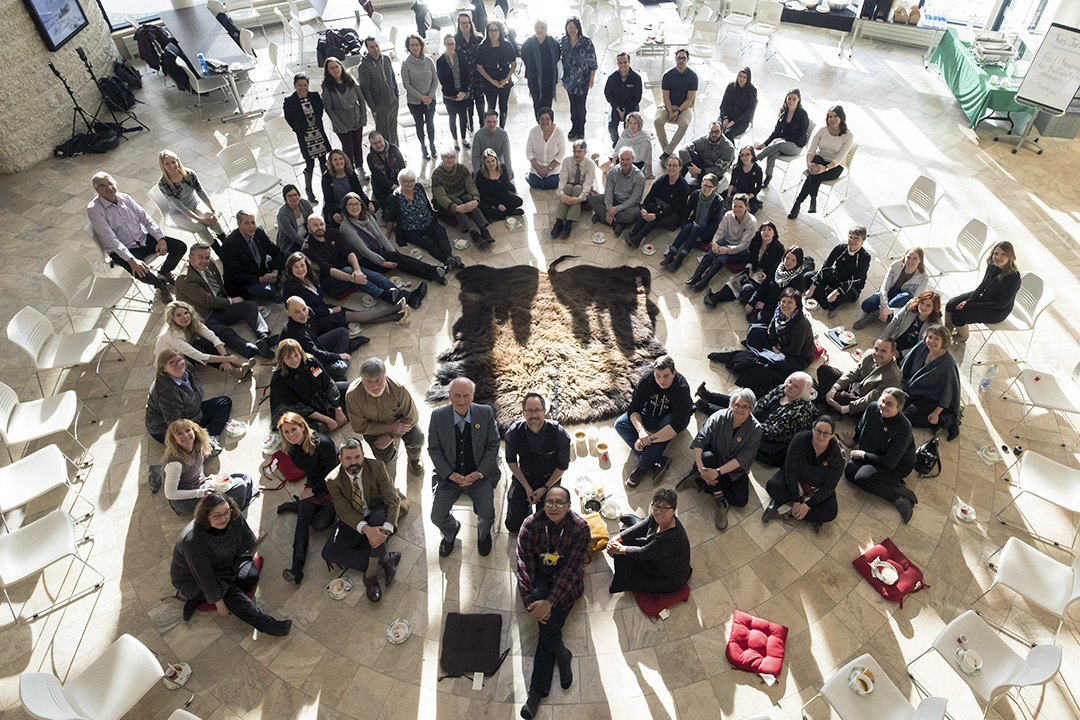
Buffalo Circle Campaign connects non-Indigenous allies
Properly and respectfully introducing Indigenous ways of teaching, learning and living into a complex education system steeped in tradition can be an intimidating undertaking.
By Meghan SiredStaff and faculty often rely heavily on their Indigenous colleagues to help guide the process, according to Dr. Stryker Calvez (PhD), manager of Indigenous Education Initiatives in the Gwenna Moss Centre for Teaching and Learning at the University of Saskatchewan.
Calvez, who is Métis from the Red River territory, said Indigenous faculty and staff are often placed in a role of “unofficial knowledge keeper for all things Indigenous,” which is both daunting and time consuming.
“Unfortunately, their engagement in this work is expected because many people are unprepared or uncomfortable with the role of Indigenous advocate, and default to people who appear to have the ‘right’ cultural experience,” said Calvez.
“Distributing that type of work among Indigenous and non-Indigenous people with different skills, abilities and knowledges would allow Indigenous faculty and staff to focus on what interests them—whether it is to indigenize the university, support their home communities, or be involved in some other aspect of academia.”
To help address these concerns, Calvez and his colleague Dr. Rose Roberts (PhD), an education development specialist within Calvez’s office, recently launched the Buffalo Circle Campaign. The Buffalo Circle is a group of non-Indigenous senior leadership, staff and faculty at USask who were acknowledged as outstanding allies and were nominated to be part of the circle by Indigenous staff and faculty. Calvez said those who agreed to be part of the circle committed to being visible allies by wearing the Buffalo Circle regalia and to support each other.
“Indigenization, decolonization and reconciliation are unachievable without concerted engagement and support by non-Indigenous people,” said Calvez. “There’s so much more potential to change the university campus if we can engage with the whole community. We want to help the allies help themselves. Before the Buffalo Circle, allies rarely had an opportunity like this to network with each other, which means allyship was growing slowly.”
Roberts said it was important to her and Calvez to help unite the newly formed group. The teachings of the buffalo kept coming up during their planning discussions, and so they asked Elders if it was appropriate to incorporating the image and teachings of the buffalo into this initiative. Elders helped Roberts and Calvez draw metaphorical connections between the power of the herd versus the individual effort.
“In the centre of the buffalo herd are the young ones,” said Roberts, a Nihithow iskwew originally from Stanley Mission. “In this case, the young are the up-and-coming allies. In the next circle are the nurturers—they are the ones who are going to be protecting and teaching the young ones, our new allies. The outer circle has the experienced buffalo breaking new ground while guiding and protecting the inner circles.”
Calvez said the first circle of allies have prioritized what they want to do next, which is to develop a better understanding of what it means to be a Buffalo Circle ally and to continue learning about the buffalo nation and the role it plays as a teacher, nurturer and caregiver. The information the allies gain from this work will help them prepare new nominees in the fall.
Dr. Alison Oates (PhD), associate professor in the College of Kinesiology, is one of the 62 allies in the first circle. Along with other allies, Oates participated in a three-hour welcoming ceremony and later attended a traditional feast that closed the first circle with Elder Timothy Eashappie Sr., who is from Carry the Kettle First Nation east of Regina.
During her 10 years at USask, Oates has learned as much as she could about Indigenous teachings and pedagogy. She also works to find new ways to indigenize the courses she teaches.
“Originally I wondered how I going to indigenize my teaching or my research,” said Oates.
“I study the brain, and not even the cultural effect on the brain. I didn’t know what to do, but then I realized that it’s not always what you’re doing, but sometimes it’s how you’re doing it.
“I’m willing to try, and something that Stryker said always sticks with me: I have to remember to have courage and at least try. And if I get it wrong, I hope someone tells me that I got it wrong, but I’ll still keep trying.”

